Lunch With... Giampaolo Dallara
Many a prolific racing car manufacturer has vanished, but an Italian visionary has overseen his firm’s expansion in a shrinking market

We are in the Osteria delle Vigne, a typical Italian family restaurant just a few miles outside the town of Varano de Melegari. I sense that a culinary experience of epic quality is heading our way. We will be guided and served by Nicola Tambini, the grandson of the restaurant’s owner. There is no menu, no choice of wine; we will eat and drink what is put in front of us. I’m very happy to be left in the hands of Tambini and those of my lunching companion Giampaolo Dallara, founding father of the eponymous racing car manufacturer that he founded in Varano de Melegari in 1972.
Tomorrow is Dallara’s 81st birthday. At a special ceremony he will be given the first production Dallara Stradale, the company’s first road car. A simple machine, Lotus-like in concept, designed to be fun to drive on the road and on the track. Its chassis is carbon fibre, a material that this most fecund of racing car manufacturers knows very well. But first let’s go back a few centuries.
“My family has lived in Varano de Melegari and the surrounding area for 500 years,” explains Dallara. “At the beginning of the 20th century some Dallaras emigrated to the United States to work in the coal mines in Pennyslvania. I still have lots of relatives in the area.” It is fortunate for Varano de Melegari that Giampaolo’s grandparents weren’t part of that exodus, for today his company provides employment for hundreds of locals and presumably many more in the local supply chain in what has recently been branded ‘Motor Valley’. A valley that contains such illustrious names as Ferrari and Lamborghini. We’ll be visiting these companies shortly.
A plate of ravioli has arrived, four different types including artichoke parcels. A red wine from Parma is poured into generous glasses.
Born in 1936, Dallara grew up during the war. “There weren’t really any food shortages. I was very young, but I do remember fruit arriving in barrows from towards the coast and this being swapped for 30kg of wheat grown by our local farmers. The biggest impact the war had on our village was when 17 partisans were captured by the Germans and executed. As you can imagine, in a small community it removed part of a generation.
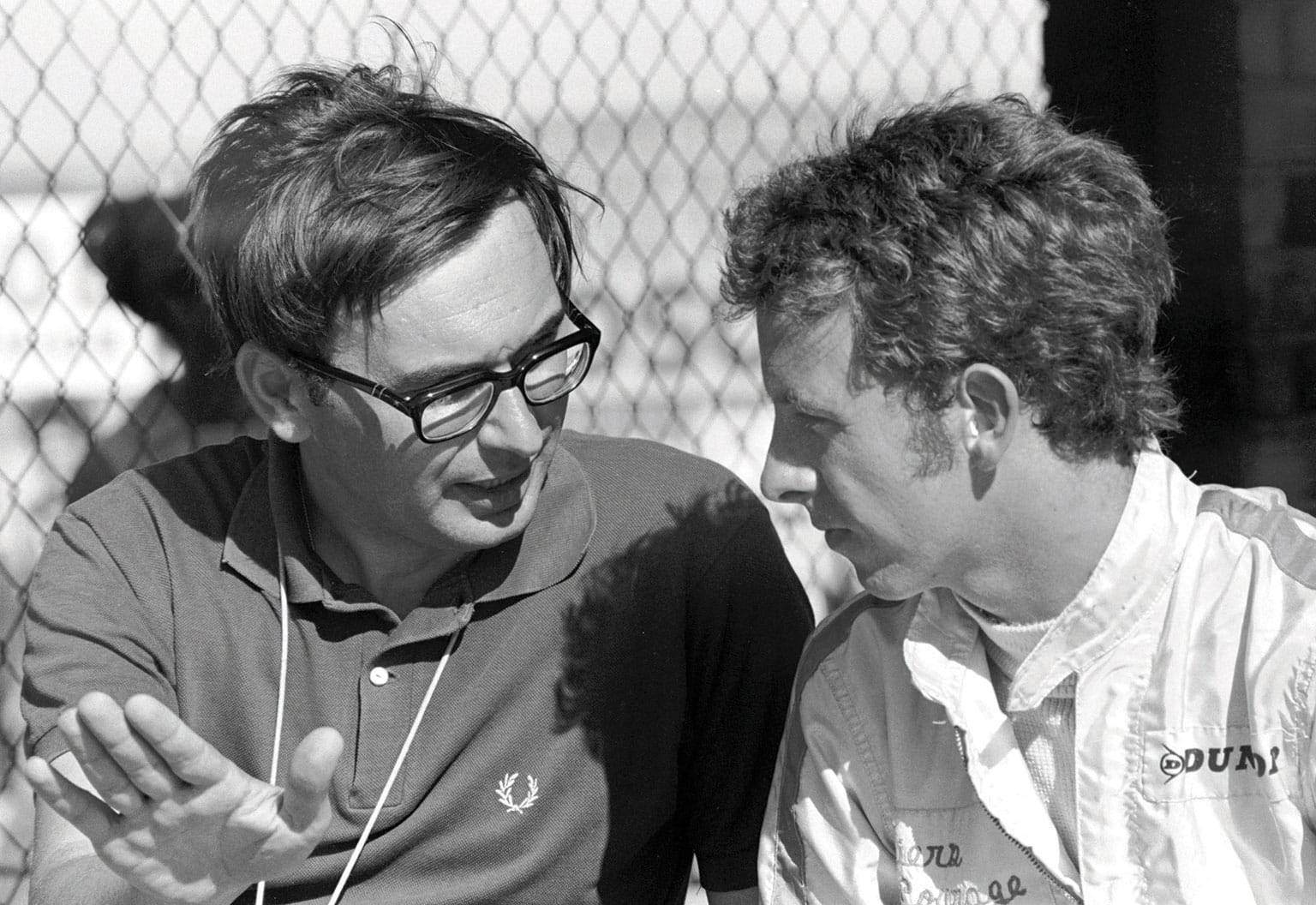
“Post-war conditions in Italy were tough and, to take our minds off the hardship, my father would take the family to watch motor races. Any races.” Was his father passionate about motor racing? “Yes, but everyone was. Absolutely everyone. I remember being taken to watch the Mille Miglia and being so incredibly close to the cars. An amazing spectacle.
“And then there were the drivers who, naturally, were hero-worshipped. The working people loved [Tazio] Nuvolari because he was closer to them in background. Achille Varzi had more style and tended to be followed by wealthier people.” These were experiences that triggered a life-long passion for racing and for cars. One that a young Dallara was determined to turn into a career. “I spent two years at university in Parma and then moved to the polytechnic in Milan. I wanted to take mechanical engineering but was unable to get a place. The only option was to study aeronautical engineering instead.”
An option that turned out to be a blessing. “A representative from Ferrari had been sent to the polytechnic,” says Dallara, “to find someone to work on aerodynamics. I put my hand up and was chosen. This was 1959 and in those days aerodynamics didn’t mean downforce, it meant improving penetration or, in other words, reducing drag.
“Ferrari was an incredible place back then. The atmosphere was amazing. I lived in a small apartment literally opposite the factory entrance. The people who you used to see coming in and out were quite something. I remember seeing Roberto Rossellini arriving with Ingrid Bergman to collect their new car, also the King of Sweden and the Shah of Iran. Royalty was always coming and going. Drivers, too. I particularly remember Phil Hill and Richie Ginther. Enzo Ferrari was like a god. I was scared of him and I think almost everybody else was, too.”
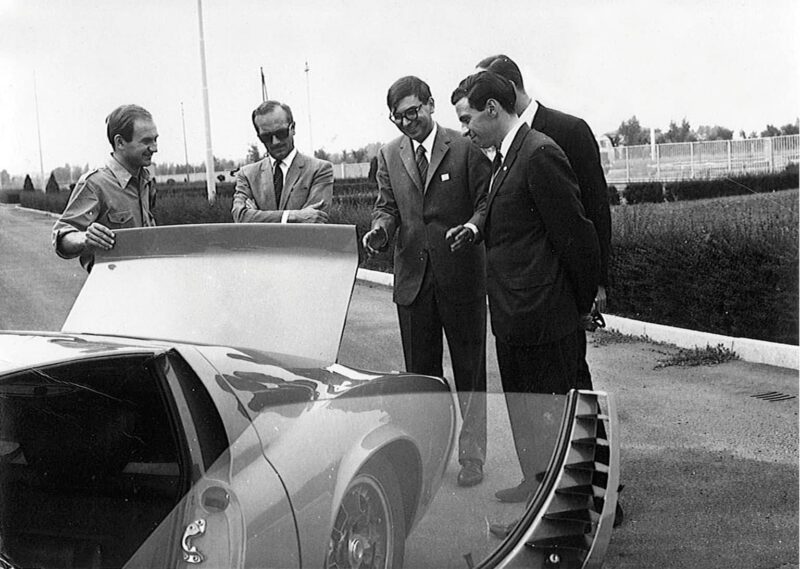
Dallar (centre) shows the Miura to visitors Clark and Chapman
Motorsport Images
The young Dallara, still only 23, worked under Carlo Chiti, who was boss of the racing department. “Ferrari was competing everywhere, all the time. It was the time of the rear-engined revolution that Ferrari said was putting the cow behind the cart. The British were well ahead of the game.” It was a dream job, designing the most famous racing cars in the world in a heyday of motor racing. A dream, but
not a perfect one.
“I was very junior, right at the bottom. I feared that my whole life would be spent in the drawing office. I would go to Monaco and other races, but I had to make my own way there and buy my own tickets. I was too lowly to be able to go with the Scuderia.”
Which is why, when Maserati approached Giampaolo with the offer of a job, he accepted. “The promise of going to races was the appeal of joining Maserati.” Clearly the young engineer was rather more than chief pencil sharpener in the Ferrari drawing office, because Mr Ferrari himself went to see Dallara’s father to ask him to persuade his son to stay at Maranello instead of debunking cross-country to Modena and Maserati. All attempts to change his mind failed and for a time Dallara seemed to have made the right decision. “Soon after I started I was sent to Sebring, where we had two Tipo 63 sports cars racing. One was driven by Roger Penske and Bruce McLaren. I can’t remember the other car’s drivers. It was incredible. A fantastic experience for me.”
In between trips to the races Dallara worked on fuel injection, made by Lucas, for Maserati’s road cars. Not surprisingly Maserati, certainly not for the first or last time, was terribly short of cash. “They did a deal to sell some machinery to South America but never got paid,” says Dallara, “so the future looked bleak.” Certainly it didn’t look like a future spent watching Maseratis winning on the world’s racetracks. Once again Dallara was approached by a car company – a start-up as we’d call it today. “Ferruccio Lamborghini came to me with the promise that once the company was fully established we’d go racing.” Four years covered Dallara being plucked from college in Milan, working at the holy of holies in Maranello, joining Maserati and now moving to fledgling Lamborghini.
“We were so busy we never had time to go racing,” says Dallara. The small team at Lamborghini worked on the 350GT and then, two years after Dallara started at the company, it showed at the 1965 Turin motor show a bare chassis complete with powertrain that would underpin the fabulous Miura. The following March, at the Geneva show, the world saw the complete car wearing Marcello Gandini’s dramatic body.
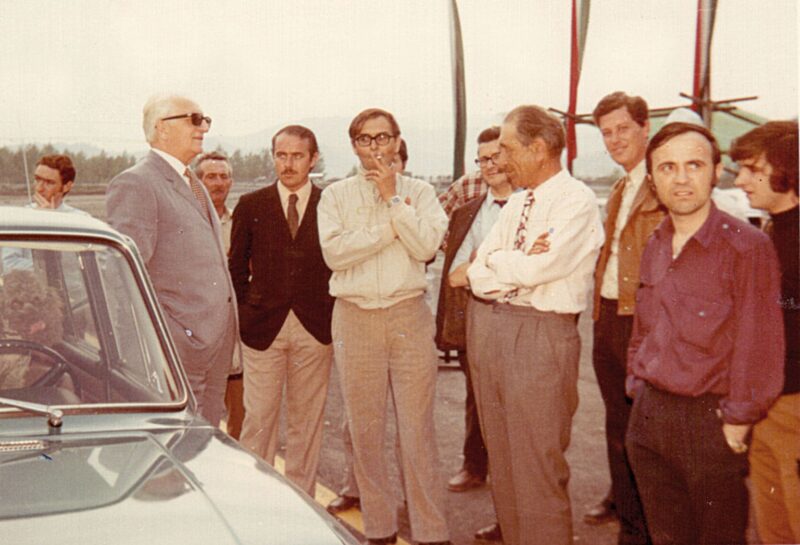
An audience with Enzo Ferrari
Motorsport Images
“Fortunately we were so inexperienced that we didn’t realise the enormity of the task we were taking on. There weren’t many of us anyway and most of us were in our 20s. It seemed at the time that both Lamborghini and Bertone were going through a golden period in which everything they touched was perfect. Although we developed the Miura in only seven months there were hardly any serious problems to overcome.”
Dallara has two engineering heroes: Colin Chapman and Alec Issigonis. “I thought the Mini was a masterpiece. When we came to designing the Miura we took the V12 from the 350GT and turned it around, fitted it transversally and used a combined transmission and final drive just like in the Mini. The Ford GT40 was also an inspiration but we couldn’t have afforded to do a pressed steel tub like the Ford’s, so we used tubing and flat steel. They were also the materials that our local craftsmen were used to working with.”
As at Ferrari, interesting people were always coming and going at Lamborghini. One day two very special visitors arrived. “I think it was in late 1967 or early 1968,” remembers Dallara, “that Colin Chapman came with Jim Clark. They just wanted to look at the Miura. A different type of people owned high-performance cars back then, it was a very different world. I remember Jean-Pierre Beltoise turning up in his Miura having driven all the way from his home in France to have his car serviced at the factory. He just hung around until the work was finished then drove it home again.”
There was still no sign of Lamborghini going racing and it looked very much like that was never going to happen. A move was required. A different sort of move: Dallara joined De Tomaso as a consultant – an odd career move until you remember one of De Tomaso’s projects in the later ’60s – the Formula 1 car. “It was the car that Frank Williams ran for Piers Courage in the 1970 season,” says Dallara. “Frank Williams was, and is, a super-fantastic person.”
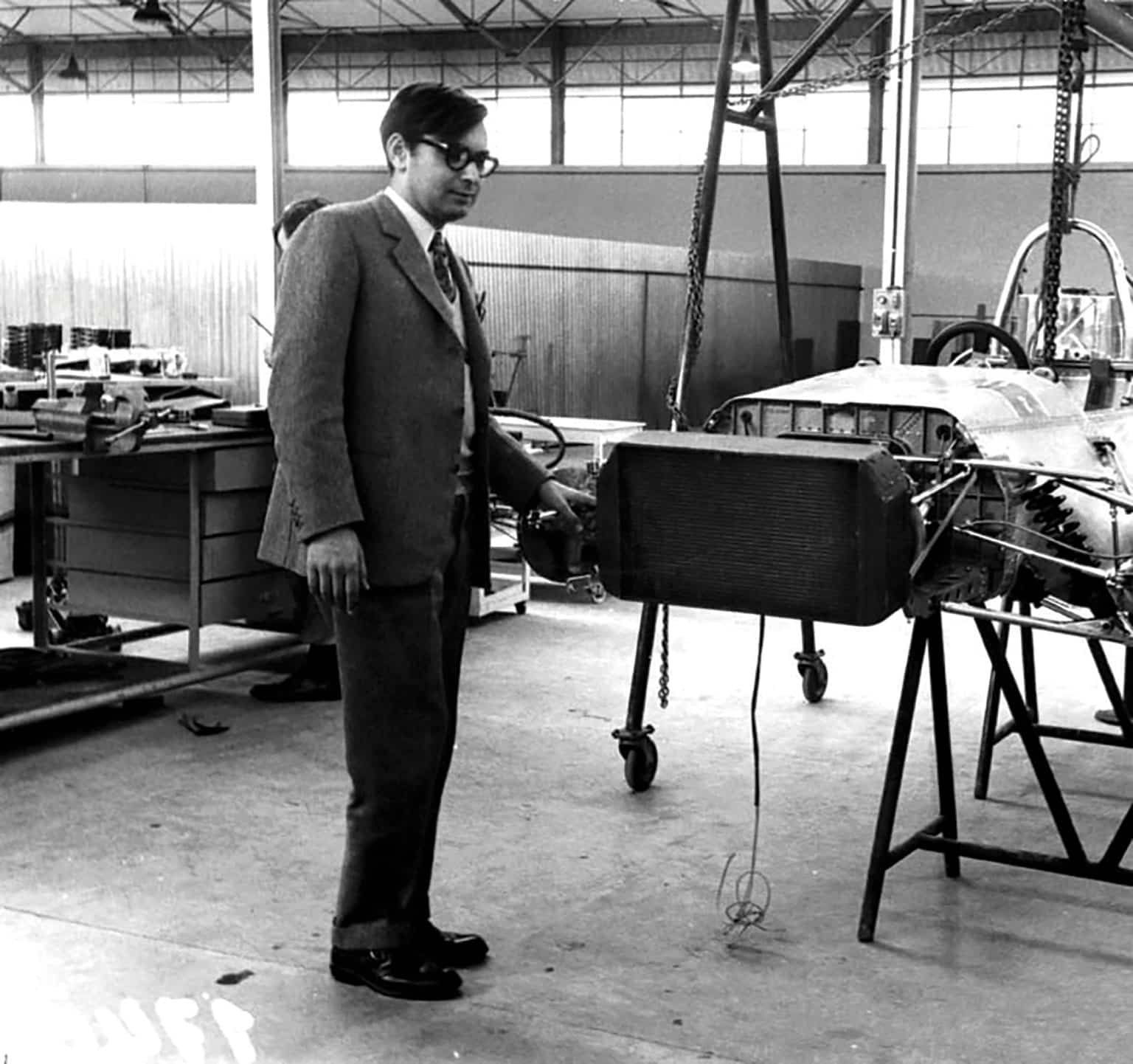
This is not the first time that I’ve spent a few hours with Giampaolo Dallara. I came to see him to talk about the Miura about 16 years ago. Lunch was not involved; I’d have remembered if we’d been to this place before. As expected, the food is fantastic. And so is Dallara’s company. Perfect English, articulate and a kindness in his voice that makes listening to him extremely relaxing. A very easy person to work for, I’d imagine.
You wouldn’t have needed a particularly powerful crystal ball to see that working for Alessandro De Tomaso might not be straightforward, and in 1972 Dallara founded his own company. Dallara Automobili da Competizione. If racing didn’t come to him, he’d go to the racing.
Early consultancy work including developing a version of the Fiat X1/9 for Group 4 racing and then a similar job for the Lancia Monte Carlo for Group 5 and another Lancia, the Group 4 version of the iconic Stratos. But it was in 1980 that Dallara really showed signs of what was to come.
“We built our first Formula 3 car in that year,” says Dallara, ‘and one of the big innovations that we introduced was using the engine as a stressed member. Colin Chapman was the first to do this with the Lotus 49 and others in F1 followed. “We were the first to do this with an F3 car, whereas previously these cars used an aluminium monocoque to which a tubular rear subframe was fitted. We fitted longer cylinder head bolts to the Novamotor engine. The engineers at Novamotor were worried that the engine would fail but it worked out fine.”
It gave Dallara an edge, but an even bigger advance was made in 1984 when the company built a wind tunnel. “We copied the specifications of the tunnel at MIRA,” says Dallara, “but also fitted a moving floor. This was the first wind tunnel in Italy to have this feature – not even Ferrari had one. The belt itself was made by a conveyor belt company, but I remembered seeing belts on farms when I was young and their convex pulleys that kept the belt running true. We made our own pulleys at the factory by turning them on our lathes.”

Tim Schenken in action during the 1973 Canadian GP, at the wheel of his Dallara-penned Iso Marlboro Williams
Motorsport Images
Dallara chassis dominated Formula 3 with dozens of championships won from Britain to Japan and to Australia. Listing all the individual successes would take the whole of this magazine. As would describing all the various collaborations over the decades. Among the stand-out cars have been Lancia’s LC1 and 2 Group C cars, Ferrari’s F50 GT1 and regular contributions to various F1 programmes.
Ah, Formula 1…
“I’ve always avoided making a large-scale commitment to F1,” says Dallara, “I have hundred of people that I am responsible for and I was never prepared to risk the company and their livelihoods by staking everything in creating my own team.” In the earliest days of the company Dallara built the Iso Marlboro Williams for his friend Frank, then the Wolf in 1977 and in 1988 a collaboration with Scuderia Italia that was about as close as Dallara came to its own team. In 1997 the Dallara Indycar made its debut. With a record 17 wins at the Indy 500, Dallara is today the sole supplier of chassis to the main Indycar series and to Indy Lights.

Guido Pardini won the inaugural Italian F3 title in an Emiliani, a Dallara-modified version of an earlier Wolf. The first pure F3 Dallara followed in 1981
Motorsport Images
Hundreds of wins, dozens of championships, a myriad of racing cars over what is now almost half a century of building racing cars in Varano de Melegari. But Dallara’s favourite creation is a bicycle. “We built the bicycle that Alex Zanardi used to win a gold medal at the London Olympics. It was the most popular project that we’ve done at Dallara, with me and all the workers.”
The staff at Dallara have an average age of 34. “If I dropped dead now that would come down by four months,” says Dallara with a smile. It’s a very young average age and the number of youngsters at Dallara is going to increase when this year the Dallara Motorsport Academy opens. The building will contain a museum as well educational workshops for visitors and students. Also, it will be used by students studying for degrees in motor sport engineering.
The Dallara factory has expanded considerably in the time since I was last here. More than doubled in size. There’s a research centre for composites and even a driving simulator that is used by clients.
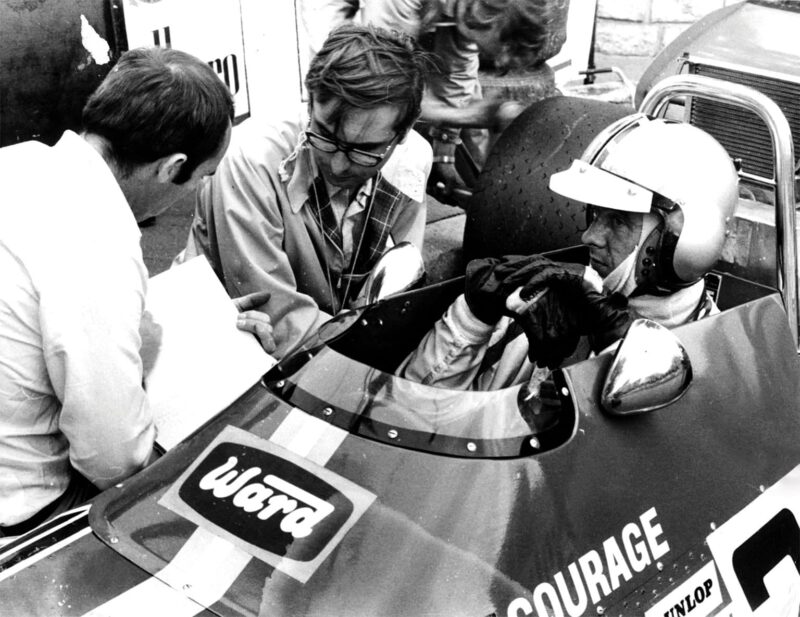
Frank Williams, Dallara and Piers Courage with the De Tomaso 505. Courage sadly lost his life in during the 1970 Dutch GP
Motorsport Images
Among the many chassis that Dallara builds today is the one for Formula E. What, I wonder, does he think about this innovative form of racing? “It’s the future. The future because it takes racing to the audience. Our local circuit at Varano (named after Riccardo Paletti) used to attract crowds of as many as 5000 spectators. Today now just a few hundred turn up and they’re friends and family of drivers or mechanics.
“My friends used to pester me for tickets to Monaco, Monza and for other F1 races, but my grandsons never ask me for tickets for F1. They’re not interested. The Formula E race in Rome will be huge because the audience is already there.”
Like many people I know, much of Dallara’s passion for motor sport is today directed at Moto GP. “I love it. I follow the races like a religion. Andrea Dovizioso and Marc Márquez are incredible riders; amazing to watch.”
The last course of a very fine meal is finished, and Dallara will take us back to the factory. He drives a modest Lancia Delta “because it fits easily into my garage”. He’s recently purchased a Miura, ironically one that was bought new by a businessman in Parma before spending the rest of its life moving around Europe before returning home for a full restoration. The car will go into the museum alongside significant Dallaras. On that visit many years ago, Dallara told me that one day he would open a museum and put a Miura in it. He also said he’d build a sports car for the road, one his hero Colin Chapman would have approved. Dallara has a lot of respect for British engineering talent. Another name he mentions is John Miles, the ex-Lotus F1 driver, journalist and engineer. “A fantastic person,” he says. “So clever. He wrote some brilliant papers on vehicle dynamics. I copied them and handed them to all our designers. If you see him, tell him I said ‘hello’.”

Formula E action from Santiago. Dallara has been involved with the pioneering electric series from day one
Motorsport Images
As we drive up the road to town a troupe of bikers come the other way. “Look, they are not riding because they have to, but for pleasure. That’s how I want our Stradale to be, a machine that people will drive for the pure pleasure of it.”
As we shake hands at the factory and say our goodbyes Giampaolo Dallara touches me on the shoulder. “Please, you won’t write anything unkind about anyone, will you?” It is hard to imagine the charismatic Dallara ever saying anything unpleasant to, or about, anyone.
